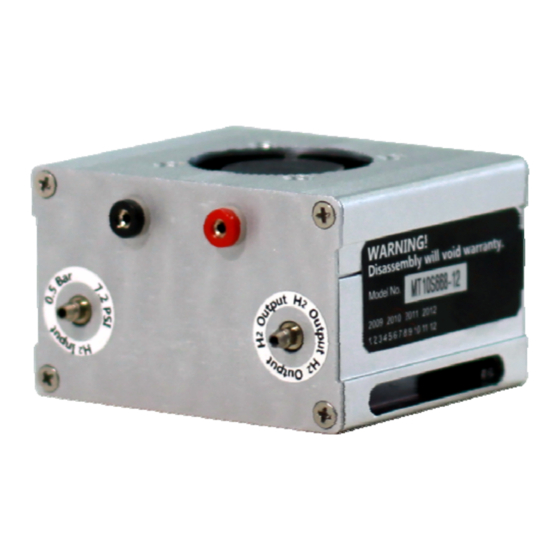
Summary of Contents for Horizon Fitness H-12
- Page 1 H-12 Fuel Cell Stack Think Big… …Start Small User Manual Updated 08 Dec. 2011 H-12_UM_ V2.4_EN...
- Page 2 It is the responsibility of the customer to meet all local safety requirements and to ensure safety during operation, maintenance and storage of the H-12 stack. Although all efforts have been made to ensure the accuracy and completeness of the information contained in this document, Horizon reserves the right to change the information at any time and assumes no liability for its accuracy.
-
Page 3: Table Of Contents
Table of Contents .................. 4 1. Safety ................9 2. Terminology ........10 3. Stack and System Component Information ............11 4. Technical Specification 5. System Performance Curves……………………………………………...…... 6. System Set-Up……………………………………………………………………. 6.1 Operating instructions ..................... 13 6.2 Simplified Drawings of HFCT Measurement Stand ..........15 .............. -
Page 4: Safety
1. Safety Please read all instructions carefully prior to product use and keep this manual for future reference. The safety guidelines included here may not cover every situation. Use common sense. 1.1 General information For this unit to generate electrical power, a supply of hydrogen fuel is necessary. It is important for any operator to be aware of, understand, and follow all local safety requirements related to the handling of hydrogen and compressed gases. - Page 5 1.3 Handling Compressed Gas Cylinders WARNING Do not handle compressed hydrogen gas cylinders without training or experience. • Use a pressure regulator to control the fuel inlet pressure to the system. • Do not alter the fitting on a regulator. Ask experienced personnel for help. •...
- Page 6 1.5 Flammability and volatility Hydrogen is flammable over concentrations of 4 – 75% by volume in air, and is explosive over concentrations of 15 – 59%. As a result, even small leaks of hydrogen have the potential to burn or explode. Leaked hydrogen can concentrate in an enclosed environment, thereby increasing the risk of combustion and explosion.
- Page 7 1.7 Electrical Safety WARNING! Avoid contact with an exposed fuel cell stack. Electrical shock can cause personal injury or death. • Do not touch fuel cell plates or any electrical components at any time. A running fuel cell stack is a potential electrical hazard that can cause burns or electrical shock. •...
- Page 8 1.8 High Temperature The fuel cell stack is designed to operate at 65ºC. At this operating temperature, the air exhaust stream temperature can reach 55ºC and the cooling air stream can reach 17ºC above ambient conditions. These temperatures are sufficient to cause burns or severe discomfort.
-
Page 9: Terminology
2. Terminology PEM fuel cell: a PEM (Proton Exchange Membrane) fuel cell is a device that converts hydrogen and oxygen into water and electricity. Reactants: reactant is a material used to start a chemical reaction. In the fuel cell the reactants are air and hydrogen by which the electricity will be generated. Humidification: humidity that the fuel cells need for running. -
Page 10: Stack And System Component Information
3. Stack and System Component Information 1. Stack 2.Plug It includes a plurality of plate- It provides higher like fuel cells arranged along hydrogen efficiency in an axis generally parallel to lower stack power cell thickness with electrically situations. conductive separator plates between each pair of cells. -
Page 11: Technical Specification
4. Technical Specifications Type of fuel cell Number of cells Rated Power Performance 7.8V @ 1.5A Purging valve voltage Blower voltage Reactants Hydrogen and Air External temperature 5 to 30ºC Max stack temperature 55ºC H2 Pressure 0.45-0.55bar ≧99.995﹪ dry H2 Hydrogen purity Humidification self-humidified... -
Page 12: System Performance Curves
5. Standard System Performance Curves... -
Page 13: System Set-Up
6. System Set-Up 6.1 Operating Instructions PLEASE READ CAREFULLY BEFORE STARTING WARNINGS: 1. The tube between the hydrogen pressure regulator and the fuel cell gas input is required to be less than 30cm. The inner diameter of the hydrogen supply tube is required to be more than 2mm. - Page 14 Step 3: Now the fuel cell system is ready to use. Please connect the load to the fuel cell system and enjoy the experience with clean energy! WARNING: Disconnect the hydrogen tube from the hydrogen input immediately after the fuel cell stack is shut down.
-
Page 15: Simplified Drawings Of Hfct Measurement Stand
6.2 Simplified Drawings of HFCT Measurement Stand Power=V x A... -
Page 16: Storage And Re-Use
7. Storage and Re-Use When finished operating the stack, place it back in the air tight container and keep it in an enclosed area for storage to keep the stack from getting too dry. The stack should be stored at room temperature. If the stack is un-used for a long period of time (more than 4 weeks) and the performance goes down 50% to the rated power at 7.8V after 30 minutes operation we recommend do the following steps. -
Page 17: Trouble Shooting
8. Trouble Shooting 1. Make sure the dry Hydrogen gas to be used must be ≥99.995% purity. 2. The tube between the hydrogen pressure regulator and the fuel cell gas input is required to be less than 30cm. 3. The inner diameter of the hydrogen supply tube is required to be more than 2mm. 4.




